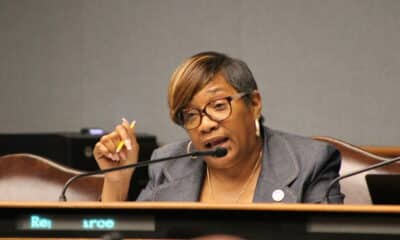Kaiser Health News
KFF Health News’ ‘What the Health?’: An Encore: 3 HHS Secretaries Reveal What the Job Is Really Like
Thu, 05 Oct 2023 09:00:00 +0000
The Host
Julie Rovner
KFF Health News
Julie Rovner is chief Washington correspondent and host of KFF Health News’ weekly health policy news podcast, “What the Health?” A noted expert on health policy issues, Julie is the author of the critically praised reference book “Health Care Politics and Policy A to Z,” now in its third edition.
This week, while KFF Health News’ “What the Health?” takes a break, here’s an encore of a favorite episode this year: Host and chief Washington correspondent Julie Rovner leads a rare conversation with the current and two former secretaries of Health and Human Services. Taped in June before a live audience at Aspen Ideas: Health, part of the Aspen Ideas Festival, in Aspen, Colorado, Secretary Xavier Becerra and two of his predecessors, Kathleen Sebelius and Alex Azar, talk candidly about what it takes to run a department with more than 80,000 employees and a budget larger than those of many countries.
Among the takeaways from this week’s episode, originally aired in June:
- The Department of Health and Human Services is much more than a domestic agency. It also plays a key role in national security, the three HHS secretaries explained, describing the importance of the “soft diplomacy” of building and supporting health systems abroad.
- Each HHS secretary — Sebelius, who served under former President Barack Obama; Azar, who served under former President Donald Trump; and Becerra, the current secretary, under President Joe Biden — offered frank, sobering, and even funny stories about interacting with the White House. “Anything you thought you were going to do during the day often got blown up by the White House,” Sebelius said. Asked what he was unprepared for when he started the job, Azar quipped: “The Trump administration.”
- Identifying their proudest accomplishments as the nation’s top health official, Azar and Becerra both cited their work responding to the covid-19 pandemic, specifically Operation Warp Speed, the interagency effort to develop and disseminate vaccines, and H-CORE, which Becerra described as a quiet successor to Warp Speed. They also each touted their respective administrations’ efforts to regulate tobacco.
- Having weathered recent debates over the separation of public policy and politics at the top health agency, the panel discussed how they’ve approached balancing the two in decision-making. For Becerra, the answer was unequivocal: “We use the facts and the science. We don’t do politics.”
Click to open the transcript
Transcript: An Encore: 3 HHS Secretaries on What the Job Is Really Like
[Editor’s note: This transcript, generated using transcription software, has been edited for style and clarity.]
Julie Rovner: Hello “What the Health?” listeners. We’re taking this week off from the news while KFF holds an all-staff retreat. We’ll be back next week, but in the meantime, here’s an encore of one of our favorite episodes of the year — a chat with three Health and Human Services Secretaries. We’ll be back next week with our regular news roundup.
Hello and welcome back to “What the Health?” I’m Julie Rovner, coming to you this week from the Aspen Ideas: Health conference in Aspen, Colorado. We have a cool special for you this week. For the first time, the current secretary of Health and Human Services sat down for a joint interview with two of his predecessors. This was taped before a live audience on Wednesday evening, June 21, in Aspen. So, as we like to say, here we go.
Hello. Good evening. Welcome to Aspen Ideas: Health. I’m Julie Rovner. I’m the chief Washington correspondent for KFF Health News and also host of KFF Health News’ health policy podcast, “What the Health?,” which you are now all the audience for, so thank you very much. I’m sure these people with me need no introduction, but I’m going to introduce them anyway because I think that’s required.
Immediately to my left, we are honored to welcome the current U.S. secretary of Health and Human Services, Xavier Becerra. Secretary Becerra is the first Latino to serve in this post. He was previously attorney general of the state of California. And before that, he served in the U.S. House of Representatives for nearly 25 years, where, as a member of the powerful Ways and Means Committee, he helped draft and pass what’s now the Affordable Care Act. Thank you for joining us.
Next to him, we have Kathleen Sebelius, who served as secretary during the Obama administration from 2009 to 2014, where she also helped pass and implement the Affordable Care Act. I first met Secretary Sebelius when she was Kansas’ state insurance commissioner, a post she was elected to twice. She went on to be elected twice as governor of the state, which is no small feat in a very red state for a Democrat. Today, she also consults on health policy and serves on several boards, including — full disclosure — that of my organization, KFF. Thank you so much for being here.
And on the end we have Alex Azar, who served as HHS secretary from 2018 to 2021 and had the decidedly mixed privilege of leading the department through the first two years of the covid pandemic, which I’m sure was not on his to-do list when he took the job. At least Secretary Azar came to the job with plenty of relevant experience. He’d served in the department previously as HHS deputy secretary and as general counsel during the George W. Bush administration and later as a top executive at U.S. drugmaker Eli Lilly. Today, he advises a health investment firm, teaches at the University of Miami Herbert Business School, and sits on several boards, including the Aspen Institute’s. So, thank you.
Former Secretary of Health and Human Services Alex Azar: Thank you.
Rovner: So I know you’re not here to listen to me, so we’re going to jump in with our first question. As I’m sure we will talk about in more detail, HHS is a vast agency that includes, just on the health side, agencies including the Food and Drug Administration, the National Institutes of Health, the Centers for Disease Control and Prevention, and the Centers for Medicare & Medicaid Services. The department has more than 80,000 employees around the country and throughout the world and oversees more than one and a half trillion dollars of federal funding each year. I want to ask each of you — I guess we’ll start with you — what is the one thing you wish the public understood about the department that you think they don’t really now?
Secretary of Health and Human Services Xavier Becerra: Given everything you just said, I wish people would understand that the Constitution left health care to the states. And so, as big as we are and as much as we do — Medicare, Medicaid, CHIP [Children’s Health Insurance Program], Obamacare — we still don’t control or drive health care. The only way we get in the game is when we put money into it. And that’s why people do Medicare, because we put money into it. States do Medicaid because we put money into it. And it became very obvious with covid that the federal government doesn’t manage health care. We don’t have a national system of health or public health. We have a nationwide system of public health where 50 different states determine what happens, and so one state may do better than another, and we’re out there trying to make it work evenhandedly for everyone in America. But it’s very tough because we don’t have a national system of public health.
Rovner: Secretary, what’s the thing that you wish people understood about HHS?
Former Secretary of Health and Human Services Kathleen Sebelius: Well, I agree with what Secretary Becerra has said, but it always made me unhappy that people don’t understand fully, I don’t think, the international role that HHS plays, and it is so essential to the safety and security and resilience of the United States. So we have employees across the world. CDC has employees in about 40 other countries, and helping to build health systems in various parts of the world, sharing information about how you stand up a health system, what a great hospital looks like. NIH does experiments and clinical trials all over the globe and is regarded as the gold standard. And we actually, I think, at HHS were able to do what they call soft diplomacy. And a lot of countries aren’t eager to have the State Department involved. They’re certainly not eager to see soldiers. Our trade policies make some people uncomfortable. But they welcome health professionals. They welcome the opportunity to learn from the United States. So it’s really a way often to get into countries and make friendships. And we need to monitor across the globe, as covid showed so well. When an outbreak happens someplace else in the world, we can’t wait for it to arrive on the border of the United States. Safety and security of American citizens really depends on global information exchange, a global surveillance exchange. The CDC has also trained epidemiologists in regions around the world so that they can be faster and share information. And I think too often in Congress, those line items for foreign trips, for offices elsewhere, people say, “Well, we don’t really need that. We should focus all our attention on America.” But I’ve always thought, if folks really understood how integral it is not just to our health security, but really national security, that we have these partnerships — and it’s, as I say, I think the best soft diplomacy and the cheapest soft diplomacy underway is to send health professionals all over the globe and to make those friendships.
Rovner: Do you think people understand that better since covid?
Sebelius: Maybe. You know, but some people reacted, unfortunately, to covid, saying, “Well, we put up bigger walls, and we” — I mean, no disease needs a passport, no wall stops things from coming across our borders. And I’m not sure that still is something that people take to heart.
Rovner: Secretary Azar, you actually have the most — in terms of years — experience at the department. What is it that people don’t know that they should?
Azar: So I probably would have led with what Secretary Becerra said about just how highly decentralized the public health infrastructure and leadership and decision-making is in the United States. I mean, it really — all those calls are made, and it’s not even just the 50 states. It’s actually 62 public health jurisdictions, because we separately fund a whole series of cities. I’ll concur in that. I’d say the other thing that people probably don’t understand, and maybe this is too inside baseball, is the secretary of HHS is, on the one hand, probably the most powerful secretary in the Cabinet and, on the other hand, also quite weak. So literally every authority, almost every authority, in the thousands and thousands of pages of U.S. statute that empower programs at HHS, say, “The secretary shall …” So the FDA, the CDC, CMS, all of these programs really operate purely by delegation of the secretary, because Secretary Becerra allows them to make decisions or to run programs. They are his authorities. And so the media, then, when the secretary acts, will … [unintelligible] … “How dare you,” you know, “how dare you be involved in this issue or that issue?” Well, it is legally and constitutionally Secretary Becerra’s job. And, on the other hand, you are supervising — it’s like a university, because you’re also supervising operating divisions that are global household brands. It is really like being a university president, for all that’s good and evil of that. You have to lead by consensus. You have to lead by bringing people along. You are not a dictator, in spite of what the U.S. statutes say. It’s very, very similar to that — that you, the secretary, is both powerful, but also has to really lead a highly matrixed, consensus-based organization to get things done.
Rovner: You’re actually leading perfectly into my next question, which is, how do you juggle all the moving pieces of this department? Just putting the agency heads in one room could fill a room this size. So tell us what sort of an average day for each of you would look like as secretary, if there’s such a thing as an average day.
Azar: Well, first, not an average administration, so take with a grain of salt my average day. So, interspersed among the two to five phone calls with the president of the United States between 7 a.m. and midnight, you know, other than that, um — I started every day meeting with my — you know, as secretary, you’ve got to have a team around you that’s not just your operating divisions, but I would start every morning — we would have just a huddle with chief of staff, deputy chief of staff, my head of public affairs. Often my general counsel would join that, my legislative leader. Just what’s going to hit us in the face today? Like, what are we trying to do, and what’s going to hit us in the face today? Just a situational awareness, every morning at about 8 a.m., quick huddle on that, and then diving into really the rhythm of the day of — I tried to drive — I use a book that I helped actually do some of the work on called “The 4 Disciplines of Execution,” just a tool of how do you focus and drive change in very complex organizations? So I tried to focus on four key initiatives that I spent as much of my time as secretary on leading and pushing on, and so I tried to make sure as much of my time was doing that. But then it’s reactive. You’re having to go to White House meetings constantly. You have to sign off on every regulation at the department. And so you’re in meetings just getting briefed and deciding approve or disapprove, so that rhythm constantly, and then add travel in, add evening commitments, add speeches. I’d say the biggest challenge you have as a leader in HHS is that first point of, focus, because you could be like a bobber on the water, just going with whatever’s happening, if you don’t have a maniacally focused agenda of, “I’ve got a limited amount of time. I’m going to drive change here. And if I don’t spend time every day pushing the department on this issue, being basically a burr in the saddle to make it happen, it won’t.” And you’ve just got to constantly be on that.
Rovner: Secretary Sebelius, what did your average day look like?
Sebelius: Well, I’m not going to repeat what Alex has just said. A lot of that goes on in the daily routine. First of all, I think all of us would be sent home the night before with a binder of materials — briefings for what you’re going to do the next day. So you may have 10 meetings, but each of those has a 20-page brief behind it. And then what the issues are, what the questions might be. So that’s your homework often that you’re leaving with at 7 or 8 at night. I like to run in the morning, and I would get up, read my schedule, and then go out and run on the [National] Mall because it sort of cleared my head. I’m proud of having — some of the folks may still be here — none of the detail ran before I started running, and my deal with them was, “I’m much older than you are, you know. We’re all going to run.”
Azar: They still —
Sebelius: Oh, here we go.
Azar: They still talk about it.
Sebelius: Well, one of them got to be a great marathon runner, you know. Can’t hurt. One guy started riding a bike, and I was like, “What are you doing?” I mean, if I fall, what are you going to do with the bike? I mean, am I going to carry it, are you going to carry it? I mean, who — anyway, so I started that way. You’d go then into the office. And one of the things that was not mentioned is HHS has an amazing, camera-ready studio, TV studio, that lots of other Cabinet agencies used. It has a setting that looks like “The View.” It has a stool that you can look in cameras, but two or three days a week we would do what they call “Around the Country.” So you would sit in a stool, and I’d be doing updates on the ACA or a pitch to enrollment or something about a disease, and you would literally have a cue card up that would say “Minneapolis, Andrea.” And I would say, “Good morning, Andrea.” And we would do a two-second spot in Minneapolis and they’d have numbers for me and then the camera would switch and it would be Bob in St. Louis. “Hello, Bob. How are you?” So that was a morning start that’s a little bit different. Anything you thought you were going to do during the day often got blown up by the White House: somebody calling, saying, you know, “The president wants this meeting,” “the vice president’s calling this.” So then the day gets kind of rearranged. And I think the description of who the key staff are around, but 12 operating agencies — any one of them could be a much more than full-time job. So just getting to know the NIH or, you know, seeing what CDC in Atlanta does every day, but trying to keep the leadership in touch, in tune, and make sure that — one of the things that, having been a governor and working with Cabinet agencies, that I thought was really important, is everybody has some input on everything. These are the stars, the agency heads. They know much more about health and their agencies than I would ever know. But making sure that I have their input and their lens on every decision that was made. So we had regular meetings where the flatter the organization, the better, as far as I’m concerned. They were all there and they gave input into policy decisions. But it is not a boring job and it’s never done. You just had to say at the end of the day, with this giant book, “OK, that’s enough for today. I’ll start again tomorrow, and there’ll be another giant book and here we go.”
Rovner: And your day, since you’re doing it now?
Becerra: I don’t know if it’s the pleasure or the bane of starting off virtually. Almost everything we did was via Zoom. I didn’t meet many of my team until months into the term because we were in the midst of covid. So we would start the days usually pretty early in the morning with Zooms and it would go one Zoom after the other. Of course, once we started doing more in-person activities, schedulers still thought they could schedule you pretty much one right after the other, and so they pack in as much as they can. I think all of us would say we’re just blessed to have some of the most talented people. I see Commissioner Califf from the FDA over there in the room. I will tell you, it’s just a yes … [applause] … . It’s a blessing to get to serve with these folks. They are the best in their fields. And you’re talking about some pretty critical agencies, FDA, NIH, CDC, CMS. I mean, the breadth, the jurisdiction, of CMS is immense. They do fabulous work. They are so committed. And so it makes it a lot easier. And then, of course, we all — we each have had — I have my group of counselors who are essentially my captains of the different agencies, and they help manage, because without that it would be near-impossible. And these are people who are younger, but my God, they’re the folks that every CEO looks for to sort of help manage an agency, and they’re so committed to the task. And so I feel like a kid in a candy store because I’m doing some of the things that I worked on so long when I was a member of Congress and could never get over the finish line. Now I get to sort of nudge everything over the finish line, and it really is helpful, as Alex said, to remind people that the statute does say, “The secretary shall … ,” not someone else, “the secretary shall … .” And so, at the end of the day, you get to sort of weigh it. And so it’s a pleasure to work with very talented, committed people.
Sebelius: Julie, I want to throw in one more thing, because I think this is back to what people don’t know, but it’s also about our days. There’s an assumption, when administrations change, the whole agency changes, right? Washington all changes. In a department like HHS, 90,000 employees scattered in the country and around the world, there are about 900 total political appointees, and they are split among all the agencies and the secretary’s office there. So you’re really talking about this incredibly talented team of professionals who are running those agencies and have all the health expertise, with the few people across the top that may try to change directions and put — but I think there’s an assumption that sort of the whole group sweeps out and somebody else sweeps in, and that really is not the case.
Rovner: So, as I mentioned, all three of you had relevant government experience before you came to HHS. Secretary Sebelius, you were a governor, so you knew about running a large organization. I want to ask all three of you, did you really understand what you were getting into when you became secretary? And is there some way to grow up to become HHS secretary?
Azar: I mean, yeah, I — yeah, I have no excuse. My first day, right after getting sworn in — the secretary has a private elevator that goes directly up to the sixth floor where the suite is, the deputy secretary’s office to the right, secretary to the left — my first day, I’m up, headed up with my security detail, and I get off and I walk off to the right. “Mr. Secretary, no, no, no. It’s this way.” Literally, it was like — it had been 11 years, but it was like coming home to me. I was literally about to walk into my old office as deputy secretary, and they show me to the secretary’s office. And I think for the first three months, I kept thinking Tommy Thompson or Mike Leavitt was going to walk in and say, “Get the hell out of my office.” And no, so it, and it was the same people, as Secretary Sebelius said. I knew all the top career people. I’d worked with them over the course of — in and out of government — 20 years. So it was very much a “coming home” for me. And it was many of the same issues were still the same issues. Sustainable growth rate — I mean, whatever else, it was all the same things going on again, except the ACA was new. That was a new nice one you gave me to deal with also. So, yeah, thank you.
Sebelius: You’re welcome. We had to have something new.
Rovner: What were you unprepared for when you took on this job?
Azar: Well, for me, the Trump administration.
Rovner: Yeah, that’s fair.
Azar: I, you know, had come out of the Bush administration. You’re at Eli Lilly. I mean, you know, you’re used to certain processes and ways people interact. And, you know, it’s just — it was different.
Sebelius: I had a pretty different experience. The rhythm of being a governor and being a Cabinet secretary is pretty similar. Cabinet agencies, working with the legislative process, the budget. So I kind of had that sense. I had no [Capitol] Hill experience. I had not worked on the Hill or served on the Hill, so that was a whole new entity. You’re not by protocol even allowed in the department until you’re confirmed. So I had never even seen the inside of the office. I mean, Alex talked about being confused about which way to turn. I mean, I had no idea [about] anything on the sixth floor. I hadn’t ever been there. My way of entering the department — I was President [Barack] Obama’s second choice. [Former South Dakota Democratic Senator] Tom Daschle had been nominated to be HHS secretary. And that was fine with me. And I said, “I’m a governor. I’ve got two more years in my term. I’ll join you sometime.” And then when Sen. Daschle withdrew, the president came back to me and said, “OK, how about, would you take this job if you’re able to get it?” And I said, “Yes, that’s an agency that’s interesting and challenging.” So I still was a governor, so I was serving as governor, flying in and out of D.C. to get briefings so I could go through hearings on this department that I didn’t know a lot about and had never really worked with, and then would go back and do my day job in Kansas. And the day that the Senate confirmation hearing began, a call came to our office from the White House. And this staffer said, “This governor? “Yes.” “President Obama has a plane in the air. It’s going to land at Forbes Air Force Base at noon. We want you on the plane.” And I said, you know, “That’s really interesting, but I don’t have a job yet. And I actually have a job here in Kansas. And here’s my plan. You know, my plan is I’m going to wait until I get confirmed and then I’ll resign and then I’ll get on the plane and then I’ll come to D.C.” And they said, “The president has a plane in the air, and it will land. He wants you on the plane.” First boss I’d had in 20 years. And I thought, “Oh, oh, OK. That’s a new thing.” So I literally left. Secretary Azar has heard this story earlier, but I left an index card on my desk in Kansas that said, “In the event I am confirmed, I hereby resign as governor.” And it was notarized and left there because I thought, I’m not giving up this job, not knowing if I will have another job. But halfway across the country I was confirmed and they came back and said — so I land and I said, “Where am I going?” I, literally, where — I mean, I’m all by myself, you know, it’s like, where am I going? “You’re going to the White House. The president’s going to swear you in.” “Great.” Except he couldn’t swear me in. He didn’t have the statutory authority, it turns out, so he could hold the Bible and the Cabinet secretary could swear me in. And then I was taken to the Situation Room, with somebody leading the way because I’d never been to the Situation Room. And the head of the World Health Organization was on the phone, the health minister from Canada, the health minister from Mexico, luckily my friend Janet Napolitano, who was Department of Homeland Security secretary — because we were in the middle of the H1N1 outbreak, swine flu, nobody knew what was going on. It was, you know, an initial pandemic. And everybody met and talked for a couple of hours. And then they all got up and left the room and I thought, woo-hoo, I’m the Cabinet secretary, you know, and they left? And somebody said to me later, well, “Does the White House find you a place to live?” I said, “Absolutely not. Nobody even asked if I had a place to stay.” I mean, it was 11 o’clock at night. They were all like, “Good night,” “goodbye,” “see ya.” So I luckily had friends in D.C. who I called and said, “Are you up? Can I come over? I’d like somebody to say, ‘Yay,’ you know, ‘we’re here.’” So that’s how I began.
Rovner: So you are kind of between these two. You have at least a little more idea of what it entailed. But what were you unprepared for in taking on this job?
Becerra: Probably the magnitude. Having served in Congress, I knew most of the agencies within HHS. I had worked very closely with most of the bigger agencies at HHS. As AG — Alex, I apologize — I sued HHS quite a —
Azar: He sued me a lot.
Becerra: Quite a few times.
Azar: Becerra v. Azar, all over the place.
Becerra: But the magnitude. I thought running the largest department of justice in the land other than the U.S. Department of Justice was a pretty big deal. But then you land and you have this agency that just stretches everywhere. And I agree with everything that Kathleen said earlier about the role that we play internationally. We are some of the best ambassadors for this country in the world because everyone wants you to help them save lives. And so it really helps. So the magnitude — it just struck me. When President Biden came in, we lost the equivalent of about — what, 13 9/11 twin tower deaths one day. Every day we were losing 11 twin tower deaths. And it hits you: You’ve got to come up with the answer yesterday. And so the White House is not a patient place, and they want answers quickly. And so you’re just, you’re on task. And it really is — it’s on you. You really — it smothers you, because you can’t let it go. And whether it was covid at the beginning or monkeypox last year, all of a sudden we see monkeypox, mpox, starting to pop up across the country. And it was, could this become the next covid? And so right away you’ve got to smother it. And the intensity is immediate. Probably the thing that I wasn’t prepared for as well, along with the magnitude, was, as I said, the breadth. Came in doing all these Zooms virtually to try to deal with the pandemic. But probably the thing that I had to really zero in on even more, that the president was expecting us to zero in on more, was migrant kids at the border and how you deal with not having a child sleep on a cement floor with an aluminum blanket and just trying to deal with that. It won’t overwhelm you necessarily, but — and again, thank God you’ve got just people who are so committed to this, because at any hour of the day and night, you’re working on these things — but the immensity of the task, because it’s real. And other departments also have very important responsibilities — clearly, Department of Defense, Department of State. But really it truly is life-and-death at HHS. So the gravity, it hits you, and it’s nonstop.
Rovner: All three of you were secretary at a time when health was actually at the top of the national agenda — which is not true. I’ve been covering HHS since 1986, and there have been plenty of secretaries who sort of were in the back of the administration, if you will, but you all really were front and center in all of these things. I want to go to sort of down the line. What was the hardest decision you had to make as secretary?
Becerra: Um …
Rovner: You’re not finished yet. I should say so far.
Becerra: I mean, there have been a lot of tough decisions, but, you know, when your team essentially prepares them up and you have all this discussion, but by the time it gets to me, it really has been baked really, really well. And now it’s sort of, White House is looking at this, we are seeing some of this, we’ve got to make a call. And again, Dr. Califf could speak to this as well. At the end of the day, the decisions aren’t so much difficult. It’s that they’re just very consequential. Do you prepare for a large surge in omicron and therefore spend a lot of money right now getting ready? Or do you sort of wait and see a little bit longer, preserve some of your money so you can use some of that money to do the longer-term work that needs to be done to prepare for the next generation of the viruses that are coming? Because once you spend the dollar, you don’t have it anymore. So you got to make that call. Those are the things that you’re constantly dealing with. But again, it just really helps to have a great team.
Sebelius: So I would say I was totally fortunate that the pandemic we dealt with was relatively short-lived and luckily far, far milder than what consumed both the secretaries to my left and right, and that was fortunate. A lot of our big decision areas were under the rubric of the Affordable Care Act and both trying to get it passed and threading that needle but then implementation. And I — you know, thinking about that question, Julie, I would say one of the toughest decisions — just because it provided a real clash between me and some of the people in the White House; luckily, at the end of the day, not the president, but — was really about the contraception coverage. Reproductive health had been something I’d worked on as a legislator, as governor. I felt very strongly about it. We’d fought a lot of battles in Kansas around it, and part of the Affordable Care Act was a preventive services benefit around contraceptive care. And that was going to be life-changing for a lot of women. And how broad it should be, how many battles we were willing to take on, how that could be implemented became a clash. And I think there were people in the administration who were hopeful that you could avoid clashes. So just make a compromise, you know, eliminate this group or that group, who may get unhappy about it. And at the end of the day, I was helped not just by people in the department, but mobilized some of my women Cabinet friends and senior White House women friends. And we sort of had a little bit of a facedown. And as I say, the president ended up saying, “OK, we’ll go big. We’ll go as big as we possibly can.” But I look back on that as a — I mean, it was a consequential decision, and it was implementation — not passing the rag in the first place, but implementing it. And it had a big impact. A big impact. It’s not one I regret, but it got a little a little tense inside, but what would be friendly meetings.
Azar: I’d use the divide Secretary Becerra talked about, which is that consequential versus hard decisions, that a lot — I think one could have a Hamlet-like character. I don’t. And so making the call when it comes to you wasn’t a terribly difficult thing, even. These are life-and-death decisions, but still yourself, you know your thought processes, you think it through, it’s been baked very well, you’ve heard all sides. You just have to make that call. So I’d maybe pivot to probably it’s more of a process thing. The hardest aspect for me was just deciding when do you fight and when do you not fight with, say, the White House? What hills do you die on? And where do you say, “Yeah, not what I would do, but I just have to live to fight another day.” Those were probably the toughest ones to really wrestle with.
Rovner: Was there one where you really were ready to die on the hill?
Azar: There were a lot. There were a lot. I mean, I’ll give you one example. I mean, I left a lot of blood on the field of battle just to try to outlaw pharmaceutical rebates, to try to push those through to the point of sale. I probably stayed to the end just to get that dag — because I, the opponents had left the administration and I finally got that daggone rule across the finish line right at the end. And that was something that I felt incredibly strongly that you could never actually change. I’ve lived inside that world. You could never change the dynamic of pharmaceutical drug pricing without passing through rebates to the point of sale. And I had so many opponents to get that done. It was a three-year constant daily battle that felt vindicated then to get it done. But that was a fight.
Rovner: And of course, I can’t help but notice that all of the things that you all are talking about are things that are still being debated today. None of them are completely resolved. Let’s turn this around a little bit. I wanted to ask you what you’re most proud of actually getting accomplished. Was it the rebate rule? That was a big deal.
Azar: For me, it has to be Operation Warp Speed. …[applause] … Yeah. Thank you. That was just — I mean, and I don’t want to take the credit. I mean, it was public-private. Mark Esper, this could not have happened without the partnership of the Defense Department, and it could not have happened without Mark Esper as secretary, because — I guarantee you, I’ve dealt with a lot of SecDefs in my career — and when the secretary of defense says to you, “Alex, you have the complete power and support of the Department of Defense. You just tell me what you need.” I haven’t heard those words before. And he was a partner and his whole team a partner throughout. And when you have the muscle of the U.S. military behind you to get something done, it is miraculous what happens. I mean, we were making hundreds of millions of doses of commercial-scale vaccine in June of 2020, when we were still in phase 2 clinical trials. We were just making it at risk. So we’re pumping this stuff out. And in one of the factories, a pump goes down. The pump is on the other side of the country on a train. The U.S. military shoots out a fighter jet, it gets out there, stops the train, pulls the train over, puts it on a helicopter, gets it on the jet, zips it off to the factory. We have colonels at every single manufacturing facility, and they get this installed. We’re up and running within 24 hours. It would have taken six to nine months under normal process. But the U.S. military got that done. So that for me was like just — the other two quick, one was banning flavored e-cigarettes. We got 25% reduction in youth use of tobacco in 12 months as a result of that. And then one of the great public health victories that this country had and the world had got ignored because it got concluded in June of 2020: We had the 11th Ebola outbreak. It was in the war zone in the eastern Democratic Republic of the Congo. This was the pandemic I was really, really worried about. One-hundred seventy-four warring groups in the war zone in the eastern Congo. Got [WHO Director-General] Tedros [Adhanom Ghebreyesus] and [then-Director of the National Institute of Allergy and Infectious Diseases Anthony] Fauci and [then-CDC Director Robert] Redfield, and we went over and we went on the ground and we got that. And by June of 2020, that one got out, which was a miracle of global public health. I’m with Kathleen on that one; I think global public health is a key instrument of American power projection humanity around the world. Sorry to go so long.
Rovner: It’s OK. Your turn.
Sebelius: I think proudest is the ability to participate in the Affordable Care Act and push that over the finish line. And for me, it was a really personal journey. My father was in Congress and was one of the votes for Medicare and Medicaid to be passed, so that chunk of the puzzle. I was the insurance commissioner in Kansas when the Republican governor asked me to do the implementation of the Children’s Health Insurance Program. So I helped with that piece. I was on President [Bill] Clinton’s patient protection commission and ended up with a lot of that package in the Affordable Care Act. And then finally to work for and support and watch a president who basically said when he announced for president, “This is my priority in my first term: I want to pass a major health care bill.” And a lot of people had made that pledge. But 15 months later, there was a bill on his desk and he signed it, and we got to implement it. So that was thrilling. Yeah. And, I should tell you, then-Congressman Becerra was one of the wingmen in the House who I worked with carefully, who — there was no better vote counter than Nancy Pelosi, but by her side was this guy, part of her delegation, named Xavier Becerra, who was whipping the votes into place. So he played a key role in making sure that crossed the finish line.
Becerra: So I’m still here, so you’re going to have to —
Rovner: You can change your answer later.
Becerra: I need a bit of grace here, because I’m going to start with Warp Speed, because I bet no one here knows there’s no longer a Operation Warp Speed. It’s now called H-CORE. And the reason I’m very proud of that is because you don’t know that it’s now H-CORE. And what makes it such a good thing is that the Department of Defense no longer has any role in the protection of the American people from covid. It’s all done in-house at HHS. Everything used to be done essentially under the auspices of the Department of Defense, because they are just the folks that can get things done in 24 hours. We do that now, and it’s the operations that were begun a while back. Kathleen had them, Alex had them. Our ASPR, that’s our Preparedness and Response team, they’re doing phenomenal work, but you don’t know it, and you don’t know that H-CORE took to flight in the first year of the Biden administration. By December of 2021, Department of Defense had transferred over all those responsibilities to us, and we’ve been doing it since. But if you ask me what am I most proud of, it’s, I mean, there are more Americans today than ever in the history of this country who have the ability to pay for their own health care because they have health insurance, more than 300 million. Part of that is Obamacare; a record number, 16 and a half million Americans, get their insurance through the marketplaces, and we haven’t stopped yet. There are close to 700 million shots of covid vaccine that have gone into the arms of Americans. That’s never been done in the history of this country. Some of you are probably familiar with three digits, 988, at a time when Americans are … [applause] … 9 in 10 Americans would tell you that America is experiencing a mental health crisis, especially with our youth. And Congress got wise and said, instead of having in different parts of the country, based on region, you could call a phone number for a suicide lifeline, if you didn’t know the 10-digit number or what part of the country you were in, you were out of luck — today, all you have to do is dial 988. But as I said before, federal government doesn’t run mental health. It’s all done by the states. But President Biden is very committed to mental health. His budgets have surpassed any type of investments that have been called for by any president in history for mental health. And he was very committed to 988 to make sure it launched right. And so we have, by exponential numbers, put money into 988 to make sure every state was ready to have it launch. And so by July of 2022, we launched 988, and it is working so well that people are actually calling — actually, not just calling. We now have a text feature and a chat feature because surprise, surprise, young people prefer not to call; they actually prefer to text. And we have increased the number of Americans who are reaching out by over 2 million, which is great, but it’s also not great because it shows you how much Americans are hurting. So there’s so many things I can tell you that I feel very good about that we’re doing. We’re not done. We’re moving beyond on tobacco where Alex left. We’re now moving to ban menthol in cigarettes. Menthol cigarettes are the most popular brand of cigarettes in America. They hook you because of the menthol, and we’re moving to extract menthol. We’re moving to ban flavored cigars and cigarillos. And we may be on course to try to see if we can move to extract as much nicotine out of tobacco as possible before it becomes a product on the market for folks to smoke. So we’re doing a whole lot of things there. And obviously on vaping, e-cigarettes as well — and Dr. Califf could mention that. But I’ll say the thing I’m probably most proud of is that, out of all the government agencies in America, federal government agencies, HHS ranks No. 2 as the best place to work. And I will tell you we’re No. 2, because if we had the capacity to tell our workforce, we will fly you to the moon and back the way NASA does, we’d be No. 1. So that’s what I think I’m most proud of, is that people, as hard as we work them, still say, “Come work at HHS.”
Rovner: So all of you have mentioned these things that were really hard to do because of politics. And you’ve all talked about how some of these decisions, when they get to you, have been baked by your staff and, you know, they vetted it with every side. But I think the public feels like politics determine everything. And I think you all would like to think that policy is what helps determine most things. So, what’s the balance? How much does politics determine what gets done, and how much is it just the idea that this would be the right policy for the American public?
Azar: Mike Leavitt, who was the secretary when I was deputy secretary, he had a phrase, and I’ll probably mangle it, but it was essentially, “Facts for science, and politics for policy.” And it’s important to remember this distinction. So, facts are facts. You gather data. We are especially a data-generating agency. But on top of that are policy overlays. And there are choices that are made about how do you use those facts? What do those facts mean? What are the implications? The United States Constitution vests under Article 2 in the president of the United States to make those choices and, as his delegee, the secretary and the other appointed leaders of the department. So there’s often this notion of politicizing science, but it’s, are there facts? Facts are facts. You generate facts. But what are the implications for policymaking? And I don’t think there’s anything illegitimate — I think is completely appropriate, whether a Democratic or Republican president — that you look and you consider all kinds of factors. Because for instance, for me, I’m going to look at things very much from a public health lens as I assess things. The secretary of the treasury, the secretary of commerce, may bring a completely and important different perspective to the table that I don’t bring. And it’s completely legitimate that that gets factored on top of whatever I or other agencies bring in as fact. So I think it takes some nuance and that we often, frankly, in public discourse don’t catch nuance. Interesting. We don’t do nuance well.
Rovner: We don’t do nuance.
Sebelius: Well, I would agree with the description of the facts versus the policy. And policy does often have political flavors. I was fortunate to work for a president who said, meant, and said it over and over and over again that he would follow the science. And he did. And I had interesting political debates with people around him, on his team, about what should be done, “rewrite the guidance on this,” “do that,” “this is going to upset this group of people.” And he was very resilient and very consistent, saying, “What does the science say? What do the scientists say? That’s where we’re going,” on those areas which were really defined as giving advice to the American public on health issues, doing a variety of things. I mean, he was totally focused on listening to the science. The politics came in, as I think Secretary Azar said well, in some decisions that were brought to him, which really involved often battles between Cabinet agencies, and both were very legitimate. Again, we had pretty ferocious battles on food labeling and calorie counts and how much sodium would, should manufacturers be allowed to put in all of our manufactured goods. I’m sure many of you are aware, but, you know, American sodium levels are just skyrocketing. And it doesn’t matter what kind of salt you use at your table; it’s already baked into every loaf of bread, every pat of butter, every can of soup. And a lot of European countries have done a great job just lowering that. So the goods that are manufactured that you pick up in an EU country — Kellogg’s Corn Flakes has a third of the sodium that the Kellogg’s Corn Flakes that you get in Aspen does, just because that was a choice that those governments made. That’s a way to keep people healthy. But we would come at that through a public health perspective and argue strenuously for various kinds of limits. The Department of Agriculture, promoting farm products, supporting goods it exports, you know, not wanting to rile people up, would come in very strongly opposing a lot of those public health measures. And the president would make that call. Now, is that politics? Is it policy? Is it, you know, listening to a different lens? But he made the call and some of those battles we would win and some we would lose. But again, it’s a very legitimate role for the president to make. He’s getting input from leaders who see things through a different lens, and then he’s the ultimate decider and he would make the decision.
Becerra: So um, I’ve done politics and policy much longer than I’ve done the secretary role. And I will tell you that there is a big difference. We do do some policy, but for the most part we execute. The policy has been given to us by Congress, and to some degree the White House will help shape that policy. We have some role in policymaking because we put out guidances, and the guidance may look like it’s political or policy-driven, or we decide how much sodium might be allowed in a particular product and so forth. But for the most part, we’re executing on a policy that’s been dictated to the agencies by Congress. And I love that, because when I became AG in California, it really hit you how important it is to be able to marshal facts. And in HHS, it’s not just facts; it’s scientific facts. It is such a treat, as an attorney, to get to rely on scientific facts to push things like masking policy in the face of some hostility that went throughout the country to the point that our CDC director had to have security detail because she was getting death threats for having policies that would urge society to have masking policies for adults, for children. We do rely principally on science and the facts at HHS. Maybe folks don’t believe it, but I can put those on the table for you to take a look at. And perhaps the best example I can give you, and I don’t know if I’ll have time to connect the dots for you, because it’s a little esoteric: Title 42, which many of you got to hear about all the time in the news. Title 42 was a policy that was put in place under the Trump administration when we were in the height of the covid pandemic. We didn’t know what was causing covid, so we were trying to make sure that we protected ourselves and our borders. And so therefore, for public health reasons, we sort of closed our borders to the degree that we could, except for those who proved that they had gone through steps and so forth to be able to come in. Title 42 was used under the Trump administration, under the Biden administration to stop people from coming through our southern border. And there reached a point where, as things got better, our team said Title 42, which is health-based — it’s to stop the spread of contagion — was no longer the appropriate tool to use at the border, because we were letting people in the northern border, by plane, and all the rest. You just had to go through protocols. And so they were saying for health care reasons you go through protocols. But Title 42 is probably not the blanket way to deal with this issue, because it’s no longer simply a health care issue. We pushed really hard on that within the administration to the point where, finally, the administration said, “We’re pulling down Title 42.” Then the politics and the policy came in, from Congress saying, “Oh, how dare you take down Title 42? How dare you do that and let the flood of people come into this country?” Well, look, if you want to deal with people coming into the country, whatever way, then deal with our country’s borders through our immigration laws, not through our health care laws. Don’t try to make health care experts be the reason why you’re stopping someone from coming into this country. Stop hiding behind their skirt. And that’s where we went. And the administration took that policy as well. They took the policy. We then got sued and a court said, “No, you will not take down Title 42.” Ultimately, we think we were going to prevail in court, but ultimately, because we pulled down the public health emergency, things got better under covid, we no longer needed Title 42. But just again, to be clear, the women and men at HHS, we execute; we use the facts and the science. We don’t do politics.
Rovner: So we’ve been very serious.
Becerra: Not everybody believed me on that one.
Rovner: I know, I know. We’ve been very serious here for 50-some minutes. I want to go down the line. What’s the most fun thing you got to do as secretary or the coolest thing that you got to do as secretary?
Azar: Probably for me, it was the trip to the Congo, you know, being in the DRC, going to Uganda, going to Rwanda, flying on MONUSCO [United Nations Organization Stabilization Mission in the Democratic Republic of the Congo] U.N. peacekeeping forces; there was a Russian gunboat taking Tedros and Fauci and Redfield and me there into this war zone. I mean, it’s a once-in-a-lifetime — it’s sort of crazy — but once-in-a-lifetime thing that had impact.
Rovner: I don’t know that most people would call that fun.
Azar: I mean, it’ll be one of those great memories for life. Yeah. Yeah.
Sebelius: There were certainly some great trips and memorable experiences around health results in various parts of the world. Some martinis on the presidential balcony and looking at the Washington Monument — that’s pretty cool at night. But my, I think, personally kind of fun thing. I raised my children on “Sesame Street,” and they loved “Sesame Street” and the characters, and that was sort of part of the family routine. And so I got to go to “Sesame Street” and make a public service commercial with Elmo. I got to see Oscar’s garbage can. I met Snuffleupagus. But the Elmo commercial was to teach kids how to sneeze because, again, we were trying to spread good health habits. And so the script said — I mean, Elmo is right here and I’m here — and the script said, “OK, Elmo, we need to practice how to sneeze. So put your arm up and bend your elbow and sneeze into your arm.” And the puppet answered, “Elmo has no elbow.” That wasn’t part of the script. It was like, really? “And if Elmo does that, it will go like this: Achoo!” OK, so we flipped the script and Elmo taught me to sneeze. But that was a very memorable day to finally be on “Sesame Street.” It was very cool.
Rovner: OK, beat that.
Becerra: My team has not yet scheduled me to go on “Sesame Street,” so it’s going to be tough.
Sebelius: But just remember, Elmo has no elbows, if you get to go.
Becerra: I think probably what I will think of most is that I had had a chance to be in the White House and meet with the president in the Oval Office and the rest as a of member of Congress and so forth. When I went in, and it was because things were kind of dire with the kids at the border, and I knew I was going to get a whiplash after the meeting — it wasn’t fun at the time, but walking out, you know, it’s the kind of thing you think of, you know, “West Wing” kind of thing. You actually got the — president sat at the table, I was the guy that sat across from him. Everybody else was to the sides. You know, for a kid who was the first in his family to go to college, Dad didn’t get past the sixth grade, Mom didn’t come here till she was 18, when she came from Guadalajara, Jalisco, Mexico. It was pretty cool.
Rovner: So I could go on all night, but I think we’re not supposed to. So I want to ask you all one last question, which is, regardless of party affiliation, what is one piece of advice you would give to a successor as HHS secretary? Why don’t you start?
Becerra: Gosh, don’t start with me because I’m still there, so —
Rovner: All right.
Azar: I’m going to plagiarize and I’m going to give you the advice I wish Donna Shalala had given me before I took the job. But I would give it to any successor, which: She told me, “Do not take the job unless you have authority over personnel. Refuse to take the job unless you have control over who’s working, because people is policy and you have to be able to control the ethics, the tone, the culture of the organization. And people are that, and you need to have that authority.” And ever really since the Reagan administration, the Office of Presidential Personnel has just been this vortex of power that controls all political appointees at Cabinet departments. And I think if the president really wants you, you need to strike a deal that says, at a minimum, I’ve got veto or firing rights.
Sebelius: I think my advice would be the advice you give to a lot of employees who work in the private sector or public sector is, Make sure you’re aligned with the mission of the CEO, so in this case the president. I mean, don’t take the job because it’s cool and you’ll be a Cabinet member, because then it will be miserable. And with HHS, recognize the incredible assets across this agency. It is the most dazzling workforce I’ve ever had an opportunity to be with — the brightest people of all shapes, sizes, backgrounds, who taught me so much every day — and just cherish and relish your opportunity to be there, even for a short period of time. It’s miraculous.
Becerra: So I’d agree with Alex: Assemble your team. And it really is, because Kathleen mentioned it, it’s a very small group that actually you get to bring in, or even the administration gets to bring in, because most of the folks are civil service, so it’s only a fraction of the people that are going to be new. But your inner circle, the team that’s going to sort of be there and guide you and tell you what’s truth, they’ve got to be your team, because someone’s got to have your back. But I’d also say, know your reach, because as Kathleen said, this is not the Azar administration or the Sebelius administration, the Becerra administration. It’s the administration of the guy who got elected. And at the end of the day, the president gets to make the call. So as much as you may want to do something, you’ve got to know your reach.
Rovner: Well, I want to thank you all. I hope the audience had half as much fun as I did doing this. Let’s do it again next year. Thank you, all. OK, that’s our show for this week. As always, if you enjoy the podcast, you can subscribe wherever you get your podcasts. We’d appreciate it if you left a review; that helps other people find us, too. Special thanks, as always, and particularly this week, to our producer, Francis Ying. Also as always, you can email us your comments or questions. We’re at whatthehealth@kff.org. Or you can tweet me. I’m @jrovner. We’ll be back in your feed from Washington next week. Until then, be healthy.
Credits
Francis Ying
Audio producer
Emmarie Huetteman
Editor
To hear all our podcasts, click here.
And subscribe to KFF Health News’ “What the Health?” on Spotify, Apple Podcasts, Pocket Casts, or wherever you listen to podcasts.
——————————
Title: KFF Health News’ ‘What the Health?’: An Encore: 3 HHS Secretaries Reveal What the Job Is Really Like
Sourced From: kffhealthnews.org/news/podcast/what-the-health-317-encore-hhs-secretaries-october-5-2023/
Published Date: Thu, 05 Oct 2023 09:00:00 +0000
Kaiser Health News
Montana’s Medicaid Expansion Conundrum – KFF Health News
SUMMARY: Montana’s Republican-led legislature and GOP governor are poised to extend the state’s Medicaid expansion program, covering 76,000 adults, beyond its June 30 expiration. With potential changes at the federal level, state lawmakers must act quickly. Discussions prioritize preparing for possible federal rollbacks, including cuts and work requirements. Recent legislation passed in the House to make expansion permanent, while other proposals suggest tightening eligibility and cost control. Although concerns over increased state costs loom if federal support decreases, some lawmakers argue against making adjustments based on uncertain federal policies. Bipartisan opposition has surfaced regarding proposals to curtail the expansion.
The post Montana’s Medicaid Expansion Conundrum – KFF Health News appeared first on kffhealthnews.org
Kaiser Health News
Texas Measles Outbreak Nears 100 Cases, Raising Concerns About Undetected Spread
SUMMARY: A measles outbreak in West Texas has led to private school closures, overwhelming local health departments. Since the outbreak began three weeks ago, 90 cases have been confirmed, mostly in children under 18, with 16 hospitalizations. Health officials fear the outbreak will worsen, and some parents may be avoiding testing their children. The outbreak has been exacerbated by low vaccination rates, particularly in communities like Gaines, which has one of the lowest vaccination rates in Texas. Local officials are working to contain the virus through pop-up clinics, mobile testing, and educating schools, but the situation remains challenging.
The post Texas Measles Outbreak Nears 100 Cases, Raising Concerns About Undetected Spread appeared first on kffhealthnews.org
Kaiser Health News
GOP Takes Aim at Medicaid, Putting Enrollees and Providers at Risk
SUMMARY: Republicans are again targeting Medicaid, proposing significant funding cuts to finance President Trump’s agenda on tax cuts and border security. Approximately 79 million people rely on Medicaid and the Children’s Health Insurance Program (CHIP), vital for numerous hospitals and states. Amid Democratic resistance, potential cuts could include reducing federal matching funds and imposing work requirements, which critics argue adds unnecessary barriers. Historically controversial, these efforts reflect deep partisan divides over Medicaid’s role as a safety net versus a welfare program. Many Americans favor Medicaid, making proposed cuts politically sensitive. The outcome remains uncertain as GOP leaders face internal challenges.
The post GOP Takes Aim at Medicaid, Putting Enrollees and Providers at Risk appeared first on kffhealthnews.org
-

 News from the South - Louisiana News Feed3 days ago
News from the South - Louisiana News Feed3 days agoJeff Landry’s budget includes cuts to Louisiana’s domestic violence shelter funding
-

 News from the South - North Carolina News Feed3 days ago
News from the South - North Carolina News Feed3 days agoBills from NC lawmakers expand gun rights, limit cellphone use
-

 News from the South - North Carolina News Feed7 days ago
News from the South - North Carolina News Feed7 days agoModest drops in some North Carolina prices under Trump | North Carolina
-

 News from the South - Arkansas News Feed7 days ago
News from the South - Arkansas News Feed7 days agoTiming out the incoming winter weather
-

 News from the South - Texas News Feed4 days ago
News from the South - Texas News Feed4 days agoICE charges Texas bakery owners with harboring immigrants
-

 News from the South - Oklahoma News Feed6 days ago
News from the South - Oklahoma News Feed6 days agoRemains of Aubrey Dameron found, family gathers in her honor
-

 News from the South - Florida News Feed7 days ago
News from the South - Florida News Feed7 days agoExpert discusses how deportations could cause labor shortages for several industries
-

 News from the South - Florida News Feed5 days ago
News from the South - Florida News Feed5 days agoTrump says AP will continue to be curtailed at White House until it changes style to Gulf of America














































